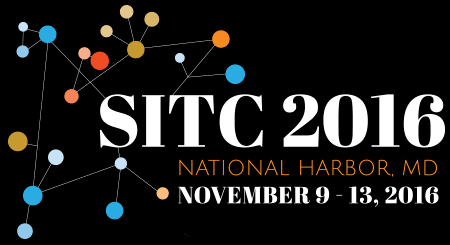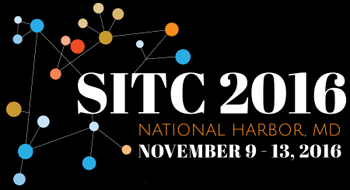Concurrent Session I: Presidential Session
Analysis of pharmacodynamic biomarkers in the first-in-human trial of GITR co-stimulation with the agonist antibody TRX-518 in patients with advanced solid cancer
The Presidential Session featured outstanding presentations of the highest-ranking abstracts authored by young investigators. Each oral presentation was judged by an expert panel to determine the winner of the Presidential Award. This year, Roberta Zappasodi, PhD (Memorial Sloan Kettering Cancer Center) was awarded the Presidential Award for her work analyzing phamacodynamic biomarkers in the first-in-human trial of GITR costimulation with the antibody agonist TRX-518. Pre-and post-treatment peripheral blood mononuclear cell (PBMC) samples were analyzed from 37 patients who received TRX-518 at increasing doses, along with pre- and post-therapy tumor biopsies from eight patients. Patients in the study had a variety of solid tumors, including melanoma (n=6), NSCLC (n=7), colorectal cancer (n=7), and other solid tumors (n=17). Among T cell populations analyzed, there was a marked reduction in circulating regulatory T cells (Treg) in both the melanoma and colorectal patients following treatment with TRX-518. Although TRX-518 was not shown to affect Treg proliferation, it was found to downregulate GITR+ Treg in a dose-dependent manner. Reflecting the findings in the periphery, tumor biopsies from melanoma and colorectal cancer patients revealed that intratumoral FoxP3+ Treg cells were also reduced after GITR costimulation. These results identify circulating Treg as a potential biomarker of TRX-518 activity and warrant further investigation to determine a potential association with clinical response.
Concurrent Session I: Microbiome and the Impact on Local Inflammation and Host Immunity
Pre-existing Immunity to Oncolytic Virus Potentiates its Therapeutic Efficacy
Jacob Ricca (Memorial Sloan-Kettering Cancer Center) presented findings on the effect of pre-existing immunity on the efficacy of oncolytic viral therapy in a murine model. B6 mice were immunized with the oncolytic Newcastle Disease Virus (NDV) and implanted with B16 melanoma or MB49 bladder cancer cells. Tumor-bearing mice, both immunized and naïve, were then given intratumoral injections of NDV. Pre-immunized mice exhibited reduced viral replication, but this did not result in reduced antitumor efficacy. Instead, pre-immunization led to superior tumor clearance and increased survival. In addition, NDV-treated animals showed a marked increase in CD8+ and CD4+ T cells, and significant decrease in CD4+ FoxP3+ T regulatory cells in the injected tumor as well as the contralateral flank tumor, which was more pronounced in pre-immunized animals. Furthermore, this study illustrated increased intratumoral accumulation of tumor-specific Trp-1 lymphocytes, and lymphocytes isolated from NDV-immunized mice produced more IFNγ when co-cultured with cancer cells. Lastly, upon tumor cell re-challenge NDV led to regression of tumor and long-term survival. Overall, these findings demonstrate that pre-existing immunity to oncolytic viruses may not inhibit, but may actually enhance the antitumor efficacy of intratumoral therapy, which is likely generated by a tumor-specific immune response.
Concurrent Session I: Diet, Exercise, Stress and the Impact on the Immune System
β-Adrenergic Signaling Induced by Cool Housing Temperatures Mediates Immune Suppression and Impairs the Efficacy of Anti-PD-1 Checkpoint Blockade Immunotherapy in Laboratory Mice
Providing the background to a study examining the effects of stress on anti-tumor immunity, Mark Bucsek (Roswell Park Cancer Institute) explained that release of norepinephrine (NE) in mice during standard cold housing temperatures (ST; 22â—‹C) in the laboratory leads to highly immunosuppressive β-adrenergic receptor (β-AR) signaling by immune cells that supports tumor growth and can be reversed with a warmer, thermoneutral environment (TT; 30â—‹C). Using varied housing temperatures and the β1/β2-blocker propranolol to modulate β-AR signaling in tumor-bearing immunocompetent and SCID mice, Bucsek found that elevation of NE levels significantly delayed tumor growth in mice housed at ST (p<0.05 vs. TT) but had little effect on mice at TT, suggesting that tumor growth at ST is mediated by β-AR signaling. When repeated in SCID mice, neither temperature nor β-blockade affected tumor growth, indicating dependence on the adaptive immune system. In subsequent experiments, tumor growth was significantly slowed in β2-AR knockout mice at ST (p<0.0001 vs. wild type), and this was dependent on increased effector function, but not quantity, of CD8+ T cells. Lastly, reduction in β-AR signaling through variation in housing temperature and use of β-blockade improved the efficacy of anti-PD-1 therapy in tumor-bearing mice, compared to β-blockade or anti-PD-1 treatment alone (both p<0.0001), in association with an increase in the number of IFNγ-producing CD8+ T cells. These data suggest that use of β-blockade treatment as adjuvant to anti-PD-1 therapy may enhance response to immunotherapy in cancer patients.
Concurrent Session II: Adoptive Cellular Therapy vs. Bispecific Antibodies
Clinical responses in advanced pancreatic patients treated with bispecific antibody armed T cells (BATS)
Lawrence G Lum, MD, DSc (University of Virginia Cancer Center) discussed a phase I clinical trial in five patients with metastatic pancreatic cancer (NCT02620865) whose T cells were armed with a bispecific antibody specific for both CD3 and EGFR (EGFR BATs), designed to direct all available T cells to the tumor in a non-MHC restricted manner. Patients were given three weekly infusions of 10, 20, and 40 x 109 EGFR BATs per infusion and a subsequent booster infusion three months later. One patient remained stable for 6.5 months following treatment with EGFR BATs and overall survival was 13.6, 14.5, 27.0, 28.6, and 31.0 months with a median overall survival of 27 months and a median time-to-progression of 6.6 months. Dr. Lum also presented data to suggest that treatment with EGFR BATs might increase responsiveness to subsequent chemotherapy. These preliminary results provide evidence that BAT therapy can yield long-lasting clinical responses.
Concurrent Session III: Emerging Technologies
Mechanisms of Chitosan/IL-12 Immunotherapy for the Treatment of Bladder Cancer
In a session focused on recently emerging technologies, Sean G. Smith (University of North Carolina – Chapel Hill and North Carolina State University) presented results of a study utilizing novel intravesical immunotherapy to engage adoptive immunity in a murine model of bladder cancer. Composed of a coformulation of the biopolymer chitosan with interleukin-12, CS/IL-12 was given intravesically twice a week for two weeks following orthotopic implantation of MB49 bladder cancer cells. In order to explore the mechanisms behind the anti-tumor response, survival was monitored following depletion of lymphocyte subtypes, and cellular responses were measured 24 hours after each treatment via flow cytometry. Results illustrated that even a single treatment with CS/IL-2 extended survival with 4/10, 2/8, 6/9, and 7/8 mice surviving long term after 1, 2, 3, or 4 treatments, respectively. Initial tumor elimination was found to be dependent on CD8+ T cells, while subsequent rejection after re-challenge was dependent on CD4+ T cells. Moreover, initial treatments were characterized by a 54% increase in macrophages in the bladder and a 56% increase in CD8:Treg ratio in the bladder-draining lymph nodes (bdLN). At treatment 3, there was an increase of CD4+ and CD8+ T cells in the bladder, with increased CD8+ T cells in the bdLN. Overall, these results illustrate the antitumor efficacy of this novel therapy and provide insight into the mechanisms of initial tumor rejection as well as memory response.
ImmunoMap: A Novel Bioinformatics Tool for Analysis of T cell Receptor Repertoire Data in Model Systems and Clinical Settings
John-William Sidhom (Johns Hopkins University) presented a novel bioinformatics tool, ImmunoMap, to visualize and quantify TCR repertoire diversity using phylogenetic and sequencing analysis. Using tumor-bearing B6 mice, the utility of ImmunoMap was demonstrated by comparing the CD8+ T cell response to self (Kb-TRP2) and foreign (Kb-SIY) antigens. The tool was also applied to analysis of tumor infiltrating lymphocytes (TIL) in tumor biopsies from patients with metastatic melanoma enrolled in a clinical trial receiving nivolumab, in order to compare the TCR repertoire of responders vs. non-responders. Analysis of CD8+ T cell response to SIY illustrated lower clonality, with TCR that were structurally similar. In contrast, response to TRP2 showed CD8+ T cells that were highly clonal but less structurally related, which may reflect effects of peripheral tolerance on self vs. foreign antigens. In the clinical trial data, unique TCR signatures were found to differentiate nivolumab responders from non-responders, and some of these could be detected prior to receiving therapy. Moreover, analysis revealed that patients whose CD8+ T cell response had a large contribution from novel and unique structural clones responded better to therapy. This new tool may enable quantification of TCR repertoire diversity from complex sequencing analyses, resulting in better understanding of CD8+ T cell responses; it may also facilitate identification of biomarker signatures that predict response.





Important Dates
Regular Abstracts Published in JITC
November 8, 2016
Late-Breaking Abstracts Published in JITC
December 8, 2016
Thank You, Supporters!
Thank you, SITC 2016 supporters. Because of your generosity, SITC 2016 was a great success!
Interested in supporting other SITC programs? Confirm your support today!


Connect with SITC!